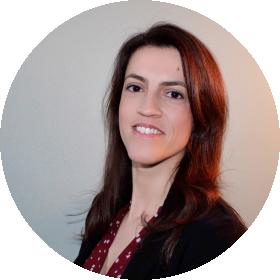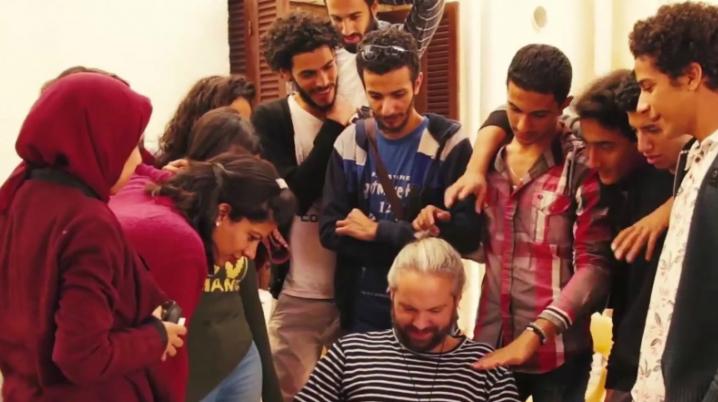
By Wladimir Riphagen
Amsterdam-based Cascoland connected with a partner in Egypt last October by giving a workshop at Mahatat, an organization specialized in artistic interventions in public spaces. Cascoland is a network of artists that aims to contribute to a more sustainable society through small-scale interventions and innovations. Among other things, they developed the Gascoland BreadDigester: an oven fuelled by biogas made of wasted bread meant for neighbourhood cooking. In Egypt, they challenged Mahatat’s artists to perform on the streets of Cairo, a form of cultural expression that usually takes place behind closed doors.
The invitation
This particular connection did not come out of nowhere. Mahatat founder Heba el Sheikh visited the Netherlands in the theme of a visitors programme produced by DutchCulture. Among other places, she visited Cascoland and noticed similarities with her own way of working in Egypt. She proceeded to invite the Amsterdammers to come and pay a visit to Cairo. Mahatat’s project involving the workshop was realized with the financial aid of the Dutch embassy in Egypt and it allowed for a Dutch professional to be invited.
Positive boost
The opportunity for Egyptian artists to access knowledge and networks in the Netherlands and to be able to invite a newly made connection provide a definite benefit. Funding opportunities such as these are a direct result of the Dutch international cultural policy, in which Egypt is a focal country. The policy seems to bear its fruits, as ever more collaborations between Dutch and Egyptian artistic professionals are made these days. An obvious boost to the creative sectors of both countries: Dutch artists gain valuable experience abroad and share insights with peers from different cultures, while at the same time, the programmes contribute to the vitality of the Egyptian cultural sector.
Follow-ups
The aftermath of the visit illustrates the positive reception of the project. For Cascoland, it kick-started the development of new plans. While in Egypt, they connected with the organisation Megawra, who also employ innovative and social methods to tackle issues in public space. For example, Megawra once creatively used a surplus in the body of groundwater to create a small park. “When we were checking out what kind of work they did, we saw so many similarities with what we do that we thought to ourselves: we’ve got to act on this somehow,” says Judith Leijdekkers of Cascoland. She is currently working hard to develop the plans to go back to Cairo next year for a joint project. “We want to spend at least three weeks there and stay somewhere in the middle city. That’s what’s necessary to get an impression of what we can achieve together.”
Theatre
In September last year, the Egyptian dramatist Beshoy Adel came to visit the Netherlands in search of a partner to team up with. The Dutch embassy in Cairo funded his project, a set of five theatre plays in Upper Egypt. During his visit to the Netherlands, Beshoy made acquaintance with Master student theatre music direction Tom Jaspers, who was keen to come to Egypt. Adel decided to invite him and within two months, Tom found himself on a plane to Cairo. “Initially I was slightly worried about safety issues, as I read that there had been a violent attack in Minya, the place I was travelling to,” says Jaspers. Fortunately, his worries were not warranted. He was picked-up from Cairo to Minya by Beshoy personally and upon arrival enjoyed the comfort of the presence of a large group of actors, directors and writers. It was a familiar and comfortable artistic atmosphere he found himself in.
Imagination
Still, Jaspers had to get accustomed to working in a different way to what he would normally do. “I’m used to judge acting by the way the text is spoken. I don’t speak any Arabic, so that didn’t quite do the trick,” Jaspers explains. He decided to take a different approach. “I started focusing on the staging and the decor, so as to make it capture the imagination. That way I could make sense of the play just by observing and watching closely what was happening in each scene, without actually understanding any of the words.” In turn, the Egyptian actors and participants were quite new to this focus on staging. There were some raised eyebrows upon Jaspers’ suggestion to replace a traditional staging combination of a small painting, a window and a table with an enormous pile of chairs, but in the end the show went on.
Learning from each other
The examples described above illustrate that the stimulation of new connections between Dutch and Egyptian artists is an important factor behind the overall increase in cultural activity. Often it does not remain limited to a single activity or project. Just like the artists over at Cascoland, Tom Jaspers aims to return: “Working with youths who are excited about you for just being there is such a source of energy.” That didn’t mean that anything that Jaspers proposed would go down easily with those same youths. When he suggested a minor change in the direction of a classic Egyptian play, it was laughed off: “We’ve seen this so many times before!” It again shows the value of cultural cooperation, in which both parties are open to take lessons from each other.
Expectations
The Egyptian way of working can be quite different from ours. To Cascoland, it was previously unclear what exactly was expected of them once in Egypt. Leijdekkers: “We had no idea how many participants there would be, what the plan was, and what we were allowed to do or not.” Not a massive problem, as it suits their own way of working in some regards. Jaspers, who is equally enthusiastic about prolonging his project, initially had no idea what to expect either. Even if the task was clear – giving the final direction to five different theatre performances – the things he ended up doing still turned out to be a surprise. The lack of a premeditated plan is typical for the way of working in Egypt, but it does have a positive effect as it leaves room for flexibility and creativity.
Do you want to know more about Dutch cultural activities in Egypt? Check out the complete overview of Dutch cultural activities in Egypt in our database. If you are a cultural professional who wants to go to Egypt, feel free to contact our focal countries desk.


